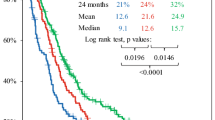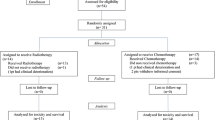Purpose:
To evaluate the efficacy of simultaneous postoperative temozolomide radiochemotherapy in glioblastoma patients.
Patients and Methods:
From February 2002 to July 2004, n = 65 patients from 11 German centers with macroscopic complete tumor resection were randomized to receive either postoperative radiotherapy alone (RT, n = 35) or postoperative radiotherapy with simultaneous temozolomide (RT + TMZ, n = 30). Patients were stratified according to age (≤/>50 years) and WHO performance score (0–1 vs. 2). RT consisted of 60 Gy in 30 fractions. In the RT + TMZ arm, oral TMZ was administered daily at a dose of 75 mg/m2 including weekends (40–42 doses). Adjuvant treatment was not given, but in both arms, patients with recurrent tumors and in good condition (WHO 0–2) were scheduled for salvage chemotherapy with TMZ.
Results:
The trial was stopped early due to the results of EORTC-study 26981-22981 that showed a survival benefit for the combination of concomitant and adjuvant TMZ compared to radiotherapy alone. In total, 62/65 patients were evaluable. Stratification variables were well balanced (≤ 50 years 26% vs. 20%, WHO 0–1 91% vs. 100%). Neither overall survival (median 17 vs. 15 months) nor progression-free survival (median 7 vs. 6 months) differed significantly between the two arms. In the RT (RT + TMZ) arm, 76% (62%) of the progressing patients received salvage chemotherapy with TMZ, 36% (50%) had a second resection. There was a time-constant trend for increased general quality of life (EORTC questionnaire QLQ C30) and brain-specific quality of life (EORTC questionnaire B20) in the combined arm. Lymphopenia G3–4 was more frequent (33 vs. 6%) in the RT + TMZ arm.
Conclusion:
After early closure of this trial, a benefit for progression-free survival for simultaneous TMZ radiochemotherapy alone could not be demonstrated. In both arms, salvage therapies were frequently used and probably had a major effect on overall survival.
Ziel:
Bestimmung der Effektivität einer alleinigen simultanen, postoperativen Radiochemotherapie mit Temozolomid bei Patienten mit Glioblastom.
Patienten und Methodik:
Von Februar 2002 bis Juli 2004 wurden n = 65 Patienten aus 11 Zentren nach makroskopischer Tumorresektion randomisiert und erhielten entweder eine postoperative lokale Strahlenbehandlung (RT, n = 35) oder eine simultane Radiochemotherapie mit Temozolomid (RT + TMZ, n = 30). Die Stratifizierung erfolgte anhand des Alters (≤/>50 Jahre) und des Allgemeinzustands (AZ) nach WHO (0–1 vs. 2). Die Bestrahlung wurde mit 60 Gy in 30 Fraktionen durchgeführt. Im RT + TMZ-Arm wurde TMZ oral in einer täglichen Dosis von 75 mg/m2 an allen Bestrahlungstagen und am Wochenende verabreicht (40–42 Dosen). Eine adjuvante Therapie mit TMZ erfolgte nicht, stattdessen war für die Patienten in gutem AZ (WHO 0–2) im Falle einer Tumorprogression in beiden Armen eine Rezidiv-Chemotherapie mit TMZ vorgesehen.
Ergebnisse:
Die Studie wurde vorzeitig nach der Veröffentlichung der EORTC-Studie 26981-22981 abgebrochen, die eine Verlängerung der Überlebenszeit durch eine simultane und adjuvante Radiochemotherapie mit TMZ gezeigt hatte. Insgesamt waren 62/65 Patienten auswertbar. Die Arme (RT vs. RT + TMZ) waren bezüglich der Stratifikationsvariablen ausgeglichen (≤ 50 Jahre 26% vs. 20%, WHO 0–1 91% vs. 100%). Weder das Gesamtüberleben (Median 17 vs. 15 Monate) noch das progressionsfreie Überleben (Median 7 vs. 6 Monate) unterschieden sich signifikant. In dem RT-(RT + TMZ-)Arm erhielten 76% (62%) der progredienten Patienten eine Rezidiv-Chemotherapie mit Temodal, 36% (50%) wurden nochmals operiert. Für die allgemeine und hirnfunktionsbezogene Lebensqualität (EORTC-Fragebögen QLQ C30 und BN20) zeigte sich in dem RT + TMZ-Arm ein zeitkonstanter Trend für bessere Werte. Im RT + TMZ-Arm war die Häufigkeit einer Lymphopenie Grad 3–4 erhöht (33% vs. 6%).
Schlussfolgerung:
Nach dem vorzeitigen Abbruch der Studie konnte ein Vorteil bezüglich des progressionsfreien Überlebens für die alleinige simultane Radiochemotherapie mit Temozolomid nicht gezeigt werden. In beiden Armen wurden Rezidivtherapien häufig eingesetzt, diese hatten wahrscheinlich einen erheblichen Einfluss auf das Gesamtüberleben.
Similar content being viewed by others
Author information
Authors and Affiliations
Corresponding author
Rights and permissions
About this article
Cite this article
Kocher, M., Frommolt, P., Borberg, S.K. et al. Randomized Study of Postoperative Radiotherapy and Simultaneous Temozolomide without Adjuvant Chemotherapy for Glioblastoma. Strahlenther Onkol 184, 572–579 (2008). https://doi.org/10.1007/s00066-008-1897-0
Received:
Accepted:
Published:
Issue Date:
DOI: https://doi.org/10.1007/s00066-008-1897-0




